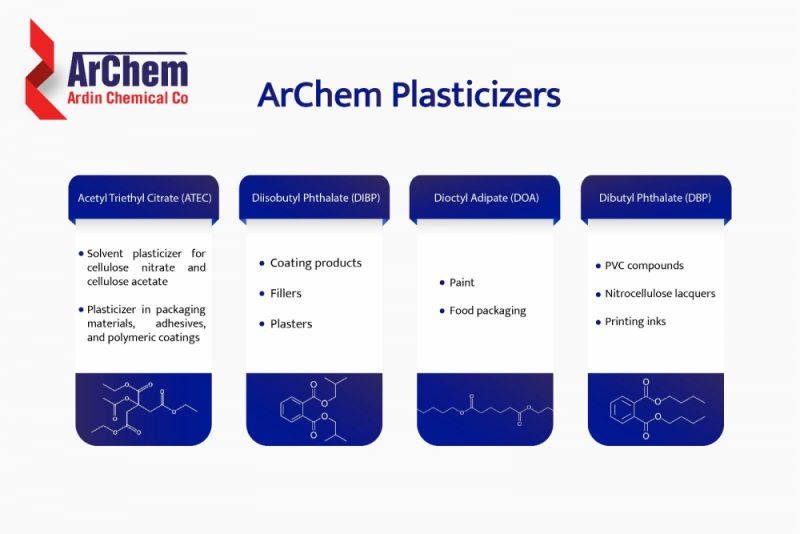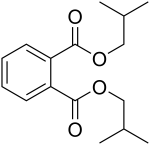Plasticizers are additives that increase the plasticity of materials. Paint and coating formulations incorporate plasticizers to resins meet flexibility and toughness requirements. The major function of the plasticizer is to increase flexibility, thus minimizing film fragility.

Selecting the right plasticizer is very important. Depending on the different ingredients used in the system, plasticizers may affect toughness, flammability, and compatibility. ArChem provides customers with different types of plasticizers, some of which include:
For more information, please contact our technical sales team in ArChem.
A plasticizer is a non/low-volatility liquid or solid substance which are generally colorless and odorless. When they are incorporated into raw polymers like a type of plastic or rubber, their flexibility would get improved and it would help us to shape and mold them easier.
Modern plasticizers are more complicated and have been designed to bring high performance in a wide range of applications safely and sustainably. They are odorless and colorless liquids that cannot be simply treated as additives like pigments or fillers. plasticizers are, in fact, crucial substances that transform the physical properties of PVC and other polymers leading to the creation of a whole new world containing flexible and durable finished articles for high-performing applications.
Incorporation of plasticizers into polymers improves:
Adding plasticizers to polymers, decrease the viscosity of the polymer melt, the glass transition temperature (Tg), the melting temperature (Tm), and the elastic modulus of the finished product, leading to a rise in the flow and thermoplasticity of the polymer without altering the fundamental chemical character of the plasticized material.
These characteristics are used to control the film formation process of coatings based on physically drying film-forming materials. Proper film formation is essential to meet demands on specific coating properties such as:
Plasticizers can be divided into two groups based on their origin, phthalate-based and non-phthalate-based. Phthalates are esters of phthalic acid. they are the most commonly used plasticizers in the world and are mainly used for the production of polyvinyl chloride (PVC) plastics and to a lesser extent for non-PVC applications, like glues, paints, and cosmetics.
when concern arouse for the reproduction toxicity of phthalates plasticizers, the use of other phthalates specifically those which are Natural and considered less toxic, increased. Some of these phthalates derived from biomass resources (vegetable oil, cardanol, vegetable fatty acid, glycerol, and citric acid) have been widely studied to replace petroleum-based o-phthalate plasticizers.
Natural plasticizers include some fatty acid esters, benzoates, tartrates and chlorinated hydrocarbons, and esters of adipic, azelaic, and sebacic acid. As the plastic industry continuously grows, the demand for plasticizers goes in the same direction.
Plasticizers are classified into 2 groups: Internal Plasticizers and External Plasticizers.
There has been much-dedicated work on the possibility of internally plasticized PVC (FPVC). However, in achieving this by copolymerization significant problems exist: (1) the affinity of the growing polymer chain for vinyl chloride rather than a comonomer implies that the incorporation of a comonomer into the chain requires significant pressure; (2) since the use of recovered monomer in PVC production is standard practice, contamination of vinyl chloride with comonomer creates additional problems, and (3) the complexity of the reaction can lead to longer reaction times and increased costs.
There are two groups of external plasticizers, primary and secondary. A primary plasticizer, when added to a polymer, causes elongation and softness to be increased. A secondary plasticizer, when added to the polymer alone, does not bring about these changes and may have limited compatibility with the polymer. However, when added to the polymer in combination with a primary plasticizer, secondary plasticizers enhance the plasticizing performance of the primary plasticizer. Secondary plasticizers are also known as extenders.
Plasticizers are produced by a reaction of an alcohol with an acid such as adipic acid, phthalic anhydride, and so forth. The choice of alcohol and acid will determine the type of ester that can be produced and hence the kind of plasticizer. The combinations are almost endless, but only a very limited number have survived the rigorous performance, cost, availability, health, and environmental requirements that are imposed by the market including by users and regulation.
To ensure high efficiency, the plasticizer should be able to penetrate the resin at film-forming conditions. Commonly used plasticizers in coatings are:

Phthalate esters, based on phthalic acid, are the main types of plasticizers used since they satisfy a broad range of processing and performance requirements, as well as a large number of markets. Major phthalates include di(2- ethylhexyl)phthalate (DEHP), also known as dioctyl phthalate (DOP); diisononyl phthalate (DINP); diisodecyl phthalate (DIDP); and di(2-propyl heptyl) phthalate (DPHP). Non-phthalate plasticizers are not based on phthalic acid and have a different chemical structure and toxicological profile. These include terephthalates (the most common is dioctyl terephthalate [DOTP]), epoxy, aliphatics, trimellitates, polymerics, phosphates, and others.
Plasticizers have different applications in various industries. Some of these applications include:
Plasticizers are used in coating formulations (for instance in NC lacquers) for the following purposes:
Plasticizers may be solvents or non-solvents in the binder. For example, NC is soluble in plasticizers such as dibutyl phthalate (DBP), di-iso-octyl phthalate (DIOP), di-octyl phthalate (DOP) & tricresyl phosphate. However, NC is insoluble in plasticizers like main stearates and oleates.
Plasticizers are also used in inks to make the dried print more flexible. For example, inks that dry by evaporation tend to be quite brittle. Folding or wrinkling such printed material can cause the ink film to crack and loosen. Plasticisers – including some phthalates, benzoates, and citrates – help give elasticity to the ink films, allowing them to bend or crease without breaking apart.
In paints, plasticizers are used for similar enhancing properties. Triacetates, for example, are widely used to make paint softer, improve its elasticity, and minimize the cracking of the final coating. Plasticizers are mostly used in industrial appliance and automotive coatings rather than architectural or DIY (do-it-yourself) paints. They can, however, be used in coatings and other applications for which very low levels of emissions are required.
Plasticizers are often used in the manufacture of pharmaceutical products. More specifically, they can be used in coatings and films and as solvents in the preparation of certain products. In pharmaceutical coatings, plasticizers can be used on the outer film of pills and tablets. They enable manufacturers to achieve the right amount of film flexibility to avoid cracking and peel-off. Such coatings and films protect the medicine, improving its longevity as well as the visual appeal for the user.
ArChem is pleased to provide a large number of Plasticizers for various industrial applications. Choose the Plasticizer that’s right for your application. Some of ArChem Plasticizers include:

ArChem Acetyl triethyl citrate (C14H22O8) is a clear, odorless, and colorless oily liquid. It is a water-soluble plasticizer used as a solvent plasticizer for cellulose nitrate and cellulose acetate.
Plus, Acetyl triethyl citrate is used as a plasticizer in packaging materials, adhesives, and polymeric coatings.
This plasticizer should be stored in dry and closed containers at temperatures lower than 388℃.
| Technical Properties | |
|---|---|
| structure of ATEC |  |
| Cas Number | 77-89-4 |
| Melting point | −42°C |
| Boiling point | 326 °C |
| Flash point | 147 °C |
ArChem Diisobutyl phthalate(C16H22O4) is an oily colorless and odorless plasticizer that is prepared by the esterification process of isobutanol and phthalic anhydride.
Although Diisobutyl phthalate has similar properties to DBP and can often be used as a substitute for it, it has a lower density and freezing point than dibutyl phthalate. This plasticizer can be used in coating products, fillers, plasters, and polymers.
DIBP should be stored in dry and closed containers, Separated from strong oxidants.
| Technical Properties | |
|---|---|
| structure of DIBP |  |
| Cas Number | 84-69-5 |
| Melting point | −37°C |
| Boiling point | 320 °C |
| Flash point | 185 °C |
ArChem Dioctyl adipate(C22H42O4) is an organic compound that is most often used as a PVC plasticizer. It is a colorless to yellow oily liquid in appearance. This plasticizer is compatible with nitrocellulose, ethyl cellulose, PVC, and cellulose nitrate.
Dioctyl adipate can be used to disperse pigments in paint as well as in food packaging films and seals. Plus, DOA can be used with other plasticizers such as Dioctyl Phthalate (DOP) in cold-resisting agricultural plastic film, freezing food, cable, electric wire, etc.
ArChem Dioctyl adipate should be stored in dry and closed containers, Separated from strong oxidants and strong acids.
| Technical Properties | |
|---|---|
| structure of DOA |  |
| Cas Number | 123-79-5 |
| Melting point | −67 °C |
| Boiling point | 214 °C |
| Flash point | 196 °C |
ArChem Dibutyl phthalate(C16H22O4) is a colorless to faint yellow in appearance. Most of the time, it is used in blends with other plasticizers in PVC compounds which require a low processing temperature.
Dibutyl phthalate can be used as a plasticizer in nitrocellulose lacquers, elastomers, and explosives. Plus, this plasticizer is used in printing inks and adhesives.
ArChem DBP should be stored in dry and closed containers and Containers should keep in a well-ventilated place.
| Technical Properties | |
|---|---|
| structure of DBP |  |
| Cas Number | 84-74-2 |
| Melting point | −35°C |
| Boiling point | 340°C |
| Flash point | 171 °C |
Plasticizers are added to raw polymers to make them flexible. They have different applications in various industries, including coatings, Paints, and Pharmaceuticals.
diisononyl phthalate (DINP), di-2-ethylhexyl phthalate (DEHP), and diisodecyl phthalate (DIDP)
Some of the Plasticizer advantages include:
Hydrophilic plasticizers dissolve in water.
Plasticizers are used in paint to provide elasticity. They help avoid cracking of paint films and make them flexible which enhances durability.
Plasticizers increase the thermoplasticity of a polymer by decreasing the viscosity of the polymer, the glass transition temperature (Tg), and the melting temperature (Tm) without changing the fundamental chemical properties of the plasticized material.